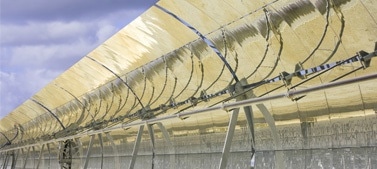A number of mechanical contractors, process designers, engineers, project managers and even homeowners send out emails and inquiries to Paratherm™ regarding the use of heat transfer fluids for solar applications.

Domestic Applications
Water/Water Glycol
Passive Solar
Passive solar systems are the simplest and least costly alternatives for direct use of solar radiation for practical purposes. Passive systems depend on natural convection for circulation. Passive solar water heating (SWH) systems, the most frequently found liquid-based passive solar applications; usually use plain water as their circulating liquid.
Active Solar
In active (pumped) SWH systems, more frequently a separate loop holding a heat transfer fluid will transfer heat to the water using a heat exchanger. The heat transfer fluid in these systems is typically a freeze protected solution of water and a glycol, with a corrosion inhibition package. Non-aqueous heat transfer fluids, such as Paratherm LR,
Power Generation and Thermal Storage
Heat transfer fluids are also employed in solar energy generation, in concentrators such as linear Fresnel, parabolic and trough-based systems. A number of heat transfer media can be utilized, based on the temperature requirements and mechanical design of the application.
- Molten salts, such as 60% NaNO3 and 40% KNO3 (220-600 °C) for thermal storage
- Water/steam is used in turbines for producing electricity
Synthetic/aromatic heat transfer fluids
- Vapor phase: Used for generating electricity in turbines, similar to steam but with more thermal efficiency
- Liquid-phase only: Used to evenly provide heat for steam in turbine generators
Polycrystalline Silicon
In conclusion, high temperature heat transfer fluids are used widely in the manufacturing processes for polysilicon, the material used to create photovoltaics, in a process similar to that used in the manufacture of computer chips.
Photovoltaic solar (PV Solar) panels are the common black panels with the bluish tinge, all solid state, that are positioned on roofs and in deserts to produce electricity directly from sunlight. Possibly the most acquainted example is the solar patio light, which absorbs solar energy during the day and then automatically lights pathways and patios at night.
The Polysilicon process which can comprise of the Siemens Reactor process or Fluid Bed (FB) reactors, in which heat transfer fluids can be used in the purification step to increase temperature of catalytic reaction to convert silicon tetrachloride (STC) to trichlorosilane (TCS). This step can be referred to as the Hydrogenation step of the process.
These units purify metallurgical grade silicon (MGS) to electronic grade silicon by hydrogenation of STC and MGS to form TCS. The resulting TCS is refined by crystallization and distillation. Heat transfer fluids are also used in the distillation process.
Other heat transfer fluids are also used in the cooling step of polysilicon production, at low temperatures. The application of cryogenic-range heat transfer fluids such as Paratherm CR is advantageous in this step. The fluid cools the molten silicon poured from crucibles into the molds making monocrystalline ingots for photovoltaics and solar cells.
Paratherm Fluids for Solar Applications
| Low Temperature Liquid |
Heating & Cooling Fluid |
High Temperature Fluids |
Paratherm CR®
- Higher Flowrates at -90 °C in Thermoprocessing
- Lowers Equipment Operating Temperatures by 10 °C
Used in polycrystalline production |
Paratherm LR™
- Water Sensitive Products
- Non-Corroding Water/Glycol Replacement
- Higher Flash Point–Rated Combustible, Not Flammable
- Low-Temp Start-up
Alternative to glycol-based fluids |
Paratherm HR™
- Synthetic/Aromatic
- Gas processing
- Chemical processes
- Waste-oil recovery
- Biodiesel production
- Plastic processing
Used in polycrystalline production and thermal solar applications.
Paratherm NF®
- Batch Processing
- Electric Immersion Heaters
- Food Grade
Used in thermal solar applications |
Paratherm does not manufacture, support or distribute glycol-based heat transfer fluids, but can recommend suppliers.

This information has been sourced, reviewed and adapted from materials provided by Paratherm.
For more information on this source, please visit Paratherm.